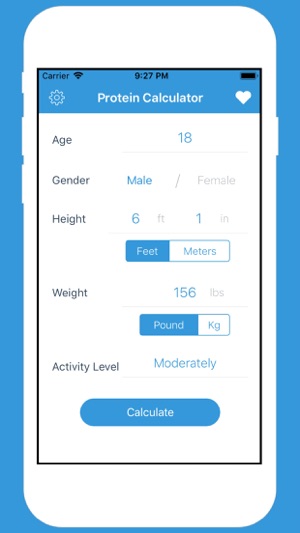價格:免費
檔案大小:28 MB
版本需求:需要 iOS 10.0 或以上版本。與 iPhone、iPad 及 iPod touch 相容。
支援語言:英語

- What are proteins?
Proteins are one of three primary macronutrients that provide energy to the human body, along with fats and carbohydrates. Proteins are also responsible for a large portion of the work that is done in cells; they are necessary for proper structure and function of tissues and organs, and also act to regulate them. They are comprised of a number of amino acids that are essential to proper body function, and serve as the building blocks of body tissue.
There are 20 different amino acids in total, and the sequence of amino acids determines a protein's structure and function. While some amino acids can be synthesized in the body, there are 9 amino acids that humans can only obtain from dietary sources (insufficient amounts of which may sometime result in death), termed essential amino acids. Foods that provide all of the essential amino acids are called complete protein sources, and include both animal (meat, dairy, eggs, fish) as well as plant-based sources (soy, quinoa, buckwheat).
Proteins can be categorized based on the function they provide to the body. Below is a list of some types of proteins1:
Antibody—proteins that protect the body from foreign particles, such as viruses and bacteria, by binding to them
Enzyme—proteins that help form new molecules as well as perform the many chemical reactions that occur throughout the body
Messenger—proteins that transmit signals throughout the body to maintain body processes

Structural component—proteins that act as building blocks for cells that ultimately allow the body to move
Transport/storage—proteins that move molecules throughout the body
As can be seen, proteins have many important roles throughout the body, and as such, it is important to provide sufficient nutrition to the body to maintain healthy protein levels.
- How much protein do I need?
The amount of protein that the human body requires daily is dependent on many conditions including overall energy intake, growth of the individual, and physical activity level. It is often estimated based on body weight, as a percentage of total caloric intake (10-35%), or based on age alone. 0.8g/kg of body weight is a commonly cited recommended dietary allowance (RDA). This value is the minimum recommended value to maintain basic nutritional requirements, but consuming more protein, up to a certain point, may be beneficial, depending on the sources of the protein.
The recommended range of protein intake is between 0.8 g/kg and 1.8 g/kg of body weight, dependent on the many factors listed above. People who are highly active, or who wish to build more muscle should generally consume more protein. Some sources2 suggest consuming between 1.8 to 2 g/kg for those who are highly active. The amount of protein a person should consume, to date, is not an exact science, and each individual should consult a specialist, be it a dietitian, doctor, or personal trainer, to help determine their individual needs.
- Foods high in protein

There are many different combinations of food that a person can eat to meet their protein intake requirements. For many people, a large portion of protein intake comes from meat and dairy, though it is possible to get enough protein while meeting certain dietary restrictions you might have. Generally, it is easier to meet your RDA of protein by consuming meat and dairy, but an excess of either can have a negative health impact. There are plenty of plant-based protein options, but they generally contain less protein in a given serving. Ideally, a person should consume a mixture of meat, dairy, and plant-based foods in order to meet their RDA and have a balanced diet replete with nutrients.

支援平台:iPhone
